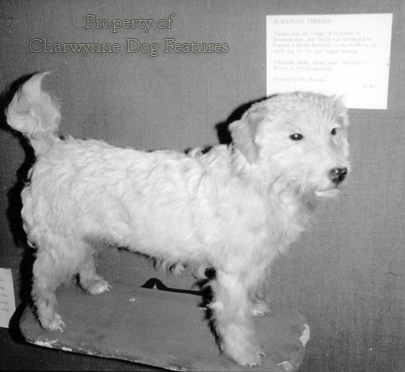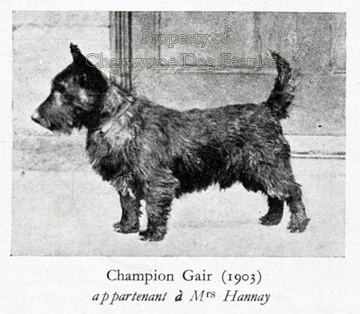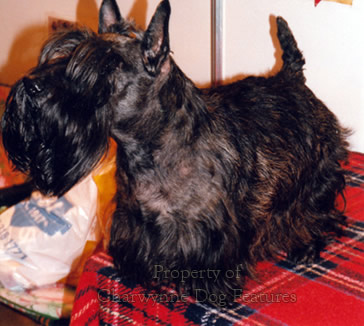1024 HEADLINES ON TERRIERS
HEADLINES ON TERRIERS
by David Hancock


Most working terrier-men worry more about skill than skull - but head shape and size do matter to any working dog, whatever its role. Many sports-loving dog-owners prefer to have a terrier as a pet because of its handy size and amusing companionship. Most terrier-owners don't go to dog shows but pet-owners buy from breeders who register their stock with the Kennel Club, and breed to the Breed Standards set out by that body. It is fair to state, I believe, that pedigree terriers are bred to the show ring type and that means pandering to the fad of the times or whim of the most influential breeder in that breed of terrier. This alters the size and the shape of our terrier breeds, as well as the length of coat. But the head of a terrier, its relative size and its proportions, matter too. The weight of a terrier's head affects the dog's balance, especially on the move. The length of a terrier's head affects the dog's use of its head, the jaw especially. Too short a muzzle affects dentition and the set of the teeth. A head size out of kilter with the rest of the dog affects the way a dog operates; a head-heavy dog brings with it, not just a lack of symmetry but changes the centre of gravity of the dog, affecting its agility and dexterity.
.jpg)

If you study old photographs of each terrier breed you can soon identify anatomical changes, with those concerning the head quite obvious and most worrying. If you look at depictions of breeds like the Fox, Sealyham, Manchester, Scottish and Welsh Terriers you can immediately see increased muzzle length often accompanied by a narrower jaw. Finding the show Sealyham too big, too cloddy, over-furnished, with disappointing temperament and whelping difficulties, Jocelyn Lucas sought a smaller-headed, harsh-coated, coloured terrier that possessed both the physique and the character for hunting. He did not care for the excessive coat and box heads of the increasingly popular post second World War show Sealyham dog. Manchester Terrier breeders feared being accused of producing 'coarse-headed' dogs and went for the 'ant-eater' muzzle. Scottish Terrier breeders seemed influenced by show ring trends in other terrier breeds for the bigger, longer, box-head.


If you then consider Bull Terriers over the last century, you spot at once a whole-scale reshaping of the skull - for no rational purpose or practical justification. The description of the Bull Terrier in 1896 produced by its breed club, established nine years earlier, used these words to describe the head: "...should be long, flat, and wide between the ears, tapering to the nose, without cheek-muscles. There should be a slight indentation down the face, without a 'stop' between the eyes." Winning dogs at the early shows featured heads roughly answering this description. A definite type emerged, based on a determined eye, a strong jaw and overall symmetry. The breed prospered, despite the harm inflicted on so many breeds by the Great War. Then, in the late 1920s, the wording of the breed standard regarding the head changed quite dramatically. The Bull Terrier's head was then expected to appear "oval, almost egg shape" with a profile ".. .almost an arc from the occiput to the tip of the nose. The more down- faced the better". For the first time in the long history of the dog, a breed was required to have an egg-shaped head. The reason for such a unique and unprecedented feature has never been stated. The Bull Terrier already had a clear identity and an established type when this rewording was agreed, so it could not have been to create a prototype. The head of the terrier was now a race for change.


The renowned Fox Terrier breeder, Rosslyn Bruce wrote repeatedly against the craze for elongated muzzles and the obliterated 'stop' that accompanied this feature, stating: "Most of the show Fox Terriers I see have over-long heads and hardly any 'stop' at all." But the Breed Standard for this breed in the 1930s contained these words on the skull: "The top line of the skull should be almost flat, sloping slightly and gradually decreasing in width towards the eyes, and should not exceed 3 and a half inches in diameter at the widest part - measuring with the calipers - in the full grown dog of correct size, the bitches; skull being proportionately narrower. If this measurement is exceeded the skull is termed 'coarse', while a full grown dog with a much narrower skull is termed 'bitchy' in head." Obsessive or what! Calipers and coarseness! Sounds more like breeders being more 'bitchy' than their dogs! But the harm done by these obsessives lives on today. Smooth Fox Terriers, Manchester Terriers and the Sealyham are all on the Kennel Club's vulnerable native breeds list; the Welsh Terrier is categorized 'at watch'. As ye sow...


“The Show Sealyham is undoubtedly a very handsome, attractive animal, and when one compares the prize-winning specimens of today with those which were first benched at the Crystal Palace Show in 1910 the improvement which has been effected is truly astonishing. Many authorities argue that the craze for a powerful, and what is termed a punishing jaw has been carried to excess..."
Fred W Lewis writing in Hounds and Dogs, The Lonsdale Library, Seeley, Service & Co., 1932.

